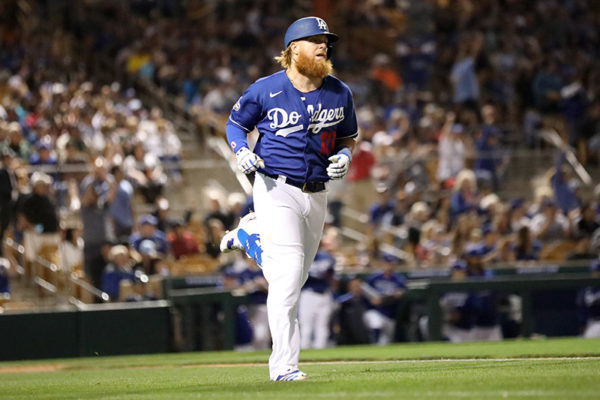
Father time is undefeated, and it looks like he might be catching up to Justin Turner.
Turner, 36 in a month, has been noticeably behind on some fastballs in this postseason. A deeper dive into the numbers shows he has struggled against fastballs this postseason, as he did during the regular season. Since both are small sample sizes, I also looked at 2019’s regular season and 2019’s postseason. Going back further than that probably wouldn’t be a good representation of what might be happening.
I, arbitrarily, used benchmarks of 4-seam fastballs, 2-seam fastballs and sinkers at 94 MPH or lower and 95 MPH or higher. Here’s what it turned up.
95 MPH or faster
| Time | BA | xBA | wOBA | xwOBA | SLG | xSLG | EV | LA |
| 2020 reg | .182 | .282 | .286 | .373 | .227 | .444 | 93.8 | 23 |
| 2020 post | .250 | .224 | .348 | .316 | .438 | .403 | 96.3 | 25.2 |
| 2019-20 reg | .253 | .281 | .321 | .365 | .368 | .458 | 89.2 | 19.4 |
| 2019-20 post | .300 | .276 | .425 | .389 | .650 | .593 | 97.4 | 23.4 |
| MLB avg 19-20 | .247 | .224 | .322 | .325 | .417 | .422 | 90.0 | 13.0 |
The 2020 regular season raw numbers are, obviously, a lot smaller of a sample size, but it also showed Turner was a bit unlucky, as his expected numbers are all substantially higher than the actual results ended up being. In the postseason, it’s the opposite, despite a higher exit velocity and launch angle. But we all saw what happened on Wednesday night. Twelve of the 19 pitches he saw on the night were 95 MPH or faster. Here’s the breakdown of those:
- 4 balls
- 3 swinging strikes
- 2 called strikes
- 2 foul balls
- 1 ball in play (bloop double)
The three swinging strikes were, well, very hittable pitches.

His bat definitely looked a bit slower, and it was magnified in the big moments.
94 MPH or slower
| Time | BA | xBA | wOBA | xwOBA | SLG | xSLG | EV | LA |
| 2020 reg | .396 | .326 | .449 | .402 | .604 | .595 | 91.9 | 17.8 |
| 2020 post | .400 | .439 | .476 | .494 | .700 | .740 | 88.4 | 28.8 |
| 2019-20 reg | .327 | .339 | .414 | .444 | .564 | .644 | 92.7 | 20.7 |
| 2019-20 post | .333 | .405 | .374 | .467 | .583 | .780 | 90.2 | 26.4 |
| MLB avg 19-20 | .288 | .287 | .370 | .374 | .508 | .513 | 90.2 | 14.0 |
No surprise here. Turner still crushes fastballs that are 94 MPH or slower. He did so in the regular season, has so far in the postseason and did so over the course of the last two seasons. What’s interesting to note is that the exit velocities in each category were significantly lower than those in the 95+ MPH table, but the results were much better here.
——
The evidence of his struggles against plus-plus fastball velo may seem more anecdotal than data-driven, but if the numbers are any indication, this could be a problem for Turner going forward. It sure is painful to see a hitter as good as he is miss some very hittable fastballs — especially in big moments. He’s not alone — a lot of the Dodger hitters do it at times — but when he couldn’t catch up to Nick Anderson‘s fastballs with the bases loaded in the bottom of the fifth inning down 5-2, it made it hurt that much more.
I’m not sure if Dave Roberts will move him down in the lineup (swap spots with Will Smith?). I don’t think he will, and lineup construction isn’t that big a deal anyway. And there’s every chance he comes up with a big hit or two for the remainder of the series, but the book could very well be out on him.
For now, this is just something to monitor for the rest of the World Series. The Rays’ bullpen arms aren’t going anywhere and Charlie Morton‘s velocity has decline for three consecutive seasons, but he still threw 11.8% of his pitches this season (regular and postseason) at 95 MPH or faster. The Dodgers are also sure to see Tyler Glasnow and (probably) Blake Snell again.
Let’s just hope Turner can work things out and come through if and when the Dodgers need him most.
 Dodgers Digest Los Angeles Dodgers Baseball Blog
Dodgers Digest Los Angeles Dodgers Baseball Blog